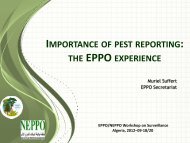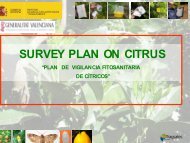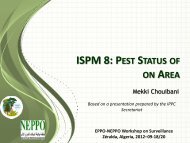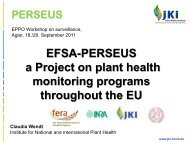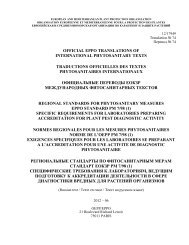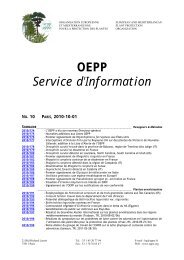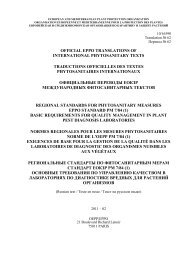EPPO Reporting Service - Lists of EPPO Standards - European and ...
EPPO Reporting Service - Lists of EPPO Standards - European and ...
EPPO Reporting Service - Lists of EPPO Standards - European and ...
Create successful ePaper yourself
Turn your PDF publications into a flip-book with our unique Google optimized e-Paper software.
<strong>EPPO</strong> <strong>Reporting</strong> <strong>Service</strong> – Pests & Diseases<br />
<strong>and</strong> tested but P. lateralis could not be detected. Positive results confirming the presence<br />
<strong>of</strong> P. lateralis were obtained in 2009 in soil <strong>and</strong> in root samples <strong>of</strong> C. lawsoniana collected<br />
from 4 distantly separated municipalities in Finistère (L<strong>and</strong>révarzec, Lopérec, Moëlan,<br />
Scaër). Although the presence <strong>of</strong> the pathogen was only confirmed in these 4 localities, it<br />
is noted that the disease has already had a serious impact on the l<strong>and</strong>scape causing decline<br />
<strong>and</strong> mortality <strong>of</strong> several thous<strong>and</strong>s <strong>of</strong> Chamaecyparis trees over an area covering<br />
approximately 400 km².<br />
In Bretagne region, in addition to typical symptoms <strong>of</strong> P. lateralis (i.e. discoloration <strong>and</strong><br />
decline <strong>of</strong> the whole canopy associated with root <strong>and</strong> collar necrosis) the presence <strong>of</strong><br />
unusual symptoms was also noted. In two sites, dead branches with necrotic lesions were<br />
observed. The decline was localized in the middle or lower part <strong>of</strong> the canopy <strong>and</strong> seemed<br />
to be progressively spreading from the foliage towards the trunk. This type <strong>of</strong> decline<br />
could not be associated with any root or collar lesions. The observation <strong>of</strong> these aerial<br />
infections without root infections suggest that in addition to dissemination by water, soil<br />
<strong>and</strong> plants, P. lateralis might be air-dispersed (as in the case for P. ramorum).<br />
The situation <strong>of</strong> Phytophthora lateralis in France can be described as follows: Present,<br />
occurs in Bretagne region (Finistère) on Chamaecyparis lawsoniana trees planted as<br />
windbreaks, under <strong>of</strong>ficial control.<br />
Source: NPPO <strong>of</strong> France (2010-12).<br />
Piou D, Robin C (2010) Rapport sur la détection de Phytophthora lateralis en<br />
Bretagne (Finistère). INRA. Ministère de l’Alimentation de l’Agriculture et de la<br />
Pêche, 14 pp.<br />
Robin C, Piou D, Feau N, Douzon G, Schenck N, Hansen EM (2011) Root <strong>and</strong> aerial<br />
infections <strong>of</strong> Chamaecyparis lawsoniana by Phytophthora lateralis: a new threat for<br />
<strong>European</strong> countries. Forest Pathology (in press).<br />
Article first published online: doi: 10.1111/j.1439-0329.2010.00688.x<br />
Additional key words: detailed record Computer codes: PHYTLA, FR<br />
2011/030 Meloidogyne chitwoodi <strong>and</strong> M. fallax detected in France<br />
The NPPO <strong>of</strong> France recently informed the <strong>EPPO</strong> Secretariat about the detection <strong>of</strong><br />
Meloidogyne chitwoodi <strong>and</strong> M. fallax (both <strong>EPPO</strong> A2 List) on its territory. In 2008, M.<br />
chitwoodi <strong>and</strong> M. fallax were detected in Picardie region on scorzonera (Scorzonera<br />
hispanica) <strong>and</strong> ware potatoes (Solanum tuberosum). Surveys on vegetable crops carried out<br />
in 2009 detected another outbreak <strong>of</strong> M. chitwoodi <strong>and</strong> M. fallax in Bretagne on glasshouse<br />
vegetables (tomatoes <strong>and</strong> lettuce). It is suspected that these outbreaks resulted from the<br />
import <strong>of</strong> infested young plants from countries where the nematodes occur.<br />
The situation <strong>of</strong> both Meloidogyne chitwoodi <strong>and</strong> M. fallax in France can be described as<br />
follows: Present, detected in 2008 in Picardie (on scorzonera <strong>and</strong> ware potatoes) <strong>and</strong><br />
in 2009 in Bretagne (on glasshouse vegetables).<br />
Source: NPPO <strong>of</strong> France (2010-11).<br />
Additional key words: detailed records Computer codes: MELGCH, MELGFA, FR<br />
4







